Title: Segou to Timbuktu (Tombouctou)
Dates: 28th Nov-5th Dec GPS:
Distance: 812km Total Distance: 3113km
Roads: 200km of rough dirt road
Weather: Approximately 30 degrees, cool nights, usual headwinds
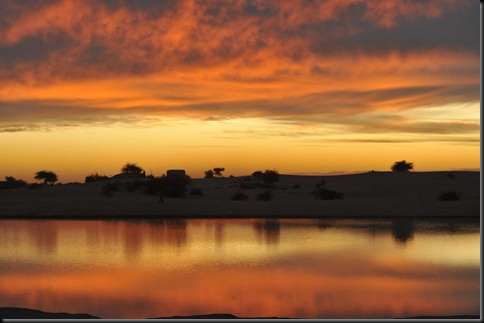
We left Segou energised and ready to appreciate some better road surfaces. We had wanted to take a short cut closer to the River Niger all the way to Djenne, but there was no guarantee that the road was free from flooding, so we opted for the main road via Bla and San (80km longer). For the first time on the expedition I felt like we were starting to get a good rhythm and cover the distances to which I am usually accustomed – consistently 130-140km, even with a constant north easterly wind. The main road skirts the Niger River floodplain. The terrain was so flat all the way to Djenne that perhaps the highest landmarks were the giant termite mounds! Our goal was to reach the ancient town in time for the famous Monday market set in front of the Grande Mosque. After two long days in the saddle we were slightly short of the town (as we expected), marked the GPS coordinates and drove to Djenne, set on an island in the Bano River, a large tributary of the Niger.
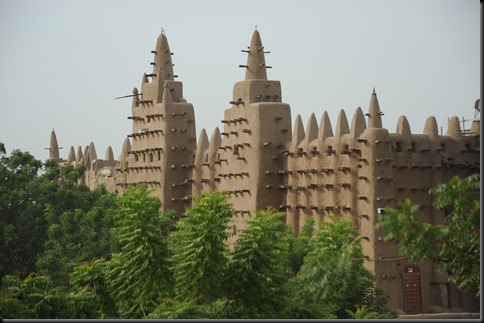
Djenne, a town of roughly 20,000 people is most famous for its mosque, the world’s largest mud building and UNESCO World Heritage Site. Djenne is a similar age and exists for similar reasons as Timbuktu; trade and education. The town is one of Mali’s premier tourist sites. We were all up early the following day in readiness to capture the Monday market as it evolved with the morning light. We had not realised that the national holiday on Saturday continued into Monday and the bustling market never eventuated. This, of course was a little disappointing, however once I found Amadou, a very good guide, we were able to spend a good couple of hours learning about the town, the mosque and its history.
The world’s largest mud building is constantly being renovated. Before the Wet season the whole community gathers to repair the walls, adding a layer of fine mud render where required. Year after year of adding to the thickness of the walls eventually means they are too thick, absorb too much weight after the rains and collapse in places. Therefore some of the walls are being reduced in size to keep the balance. Mud for the render is mixed with rice husks to make a smooth surface whereas mud for the core of the walls is combined with straw. 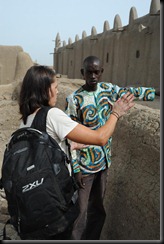 Even though we had offers to enter the building (for a decent price) we respected the wishes of the Limam (head of the Mosque) and local community and elected to stay outside. Some tourists abused the privilege a few years ago so now entry is reserved for all local men and local women who have visited Mecca. Women can only enter the mosque via a special entrance around the back of the building and once inside are not permitted to even see men.
Even though we had offers to enter the building (for a decent price) we respected the wishes of the Limam (head of the Mosque) and local community and elected to stay outside. Some tourists abused the privilege a few years ago so now entry is reserved for all local men and local women who have visited Mecca. Women can only enter the mosque via a special entrance around the back of the building and once inside are not permitted to even see men.
Like Oualata and Timbuktu, Djenne has a strong tradition of education with 22 Q’uranic schools (where they are schooled in rote learning the Q’uran), many Madrassas and now government schools. A library houses ancient manuscripts.
We retraced our route to where we had stopped cycling, camped and resumed our journey towards Sevare (near Mopti). I noticed that the floodplain was more fertile and much more was being grown. A feature of the many villages was rows of grain storehouses where their staple foods are kept for use or sale. The dinky little mud huts are built off the ground to prevent moisture seeping into the grains (usually millet, rice, sorghum). They are such a contrast to how we store grains in bulk in Australia.
Sevare, a gateway to the Dogon country (more about this when we visit the unique cultural region after Timbuktu) is very well set up for tourism, with good amenities. The write up given to Mac’s Refuge by a number of guide books is well-justified and help keep Mac ahead of the competition. We have not found better food or service to date in Africa. Cycling after Mac’s special breakfast was a real challenge. My metabolism has suitably cranked up now the process obscene amounts of food. Breakfast here included: two huge buckwheat pancakes (made from millet flour) soaked in honey, numerous pieces of French toast, a large bowl of amazing homemade muesli, two helpings of fruit salad, juice and coffee.
I cycled the 400km from Sevare to Timbuktu alone. Dan took over the filming for a couple of days as Paddy wanted some days off. The first day and a half, from Sevare to Douenza was an amazing, almost continuous procession of nomadic herders driving their stock, usually goats, sheep or cattle beside the road. Donkeys are real beasts of burden, hauling massive loads of firewood, grains, goats, people – just about anything. From about 50km before Douenza, the scenery on both sides of the road was special, my favourite of the journey so far. The hills which form the Falaise de Bandiagara to the south and near Douenza, a spectacular mountain range with sheer cliff faces rising to over a thousand metres.
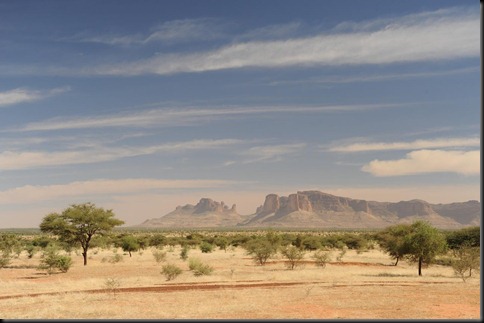
We had heard all sorts of unfavourable reports about the road to Timbuktu from Douenza and I was up for a tussle with larger tracts of sand within the 200km. Apart from some large sand patches in the final 30km before the River Niger, the road was heavily corrugated (in fact I was shaken to bits) but manageable. I conquered the road, which had definitely been upgraded, in two days. On the second night we stayed beside a nomadic farmer, who brought us firewood and swept some ground for us to camp. We in return gave them some food – basics they probably didn’t have much of, such as sugar, potatoes, onions, rice and some tinned food.
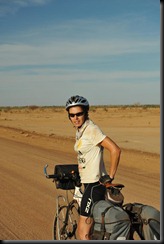 I was amazed at the size of the Niger, Africa’s third largest river. We took the barge across, which I guess to be about two kilometres. After that there were just 18km of tarmac to reach Timbuktu. I remember my grandmother often saying “from here to Timbuktu” referring to a place which was a long or inaccessible distance away. Nowadays people can fly, drive, take a boat, walk, ride a camel…but not too many people cycle to the ancient, mystical city of approximately 50,000. Europeans didn’t make to Timbuktu until the mid-1800’s. A number were killed trying. As I arrived at the hotel where we had chosen to stay I was suddenly surrounded by press, a well-known Mali media personality and a TV camera. It took me by complete surprise. Recent kidnapping incidents in Gao, 400km away and in western Mauritania have rocked the local economy, which relies heavily on tourism. They wanted to demonstrate to the public on national and African TV that Timbuktu is safe – even a woman on a bicycle can arrive safely only experiencing friendly, helpful people (completely true). Of course we had read the alerts but also have some very reliable Touareg contacts who advised that our route is safe. John knows these people, has worked with them before and has complete faith in their advice.
I was amazed at the size of the Niger, Africa’s third largest river. We took the barge across, which I guess to be about two kilometres. After that there were just 18km of tarmac to reach Timbuktu. I remember my grandmother often saying “from here to Timbuktu” referring to a place which was a long or inaccessible distance away. Nowadays people can fly, drive, take a boat, walk, ride a camel…but not too many people cycle to the ancient, mystical city of approximately 50,000. Europeans didn’t make to Timbuktu until the mid-1800’s. A number were killed trying. As I arrived at the hotel where we had chosen to stay I was suddenly surrounded by press, a well-known Mali media personality and a TV camera. It took me by complete surprise. Recent kidnapping incidents in Gao, 400km away and in western Mauritania have rocked the local economy, which relies heavily on tourism. They wanted to demonstrate to the public on national and African TV that Timbuktu is safe – even a woman on a bicycle can arrive safely only experiencing friendly, helpful people (completely true). Of course we had read the alerts but also have some very reliable Touareg contacts who advised that our route is safe. John knows these people, has worked with them before and has complete faith in their advice.
Tomorrow Paddy and I will take a classic pirogue boat on a three day, two night trip back down to Mopti to obtain a more in depth look at life on the River Niger, the lifeline for all those who live beside it. John and Dan will drive back to Sevare, 12km from Mopti. There we will rejoin the line continuing the journey through the Dogon country and on to Ouagadougou, capital of Burkina Faso.



{ 5 comments… read them below or add one }
hope you all have a good and safe christmas and the road stays enjoyable .
Kate
I am learning so much about the diversity of African countries , love your text the photos are stunning
Thinking of you and team over Xmas
Hugs from Mike I am at this moment watching 2 hot air baloons heading my way in the early sunrise.
I think what you are doing is fantastic and I would love to follow your route next year.
Hi Kate,
Geoff and I just want to wish you and your team a Christmas filled with all you want it to be!
Enjoy the day. Enjoy the ride and enjoy the people, as you so obviously are.
Take care and merry Christmas,
Geoff & Dina
P.S. We missed you at Christmas drinks on the weekend!